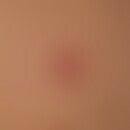DefinitionThis section has been translated automatically.
The clotting factors are mainly enzymes, but also coenzymes that accelerate the reaction. For historical reasons, the individual coagulation factors have several names, which often led to confusion. Therefore, the "International Committee for the Standardization of the Nomenclature of the Blood Clotting Factors" was founded in 1954 and the clotting factors were numbered consecutively, if possible in the order of their discovery.
The factors II, VII, IX, X, XI and XII are serine proteases. Factors II, VII, IX and X are vitamin K-dependent and are synthesized ribosomally in hepatocytes. Postribosomally, they are coenzyme co-synthesized with vitamin K to the activating factors y-carboxylated. The y-carboxyl group enables the factors to bind to the calcium-phospholipid matrix, especially in the thrombocinase complex.
The activation of the factors takes place by splitting the reactive centre. At the same time, they become accessible for inhibitors.
Common to all serine proteases are the catalytic targets serine 195, histidine 57 and asparagine 102. All serine kinases act by reversible hydrolysis and water binding. In contrast to other enzymes, the catalytic action of serine proteases is not reversible. The reason for this is on the one hand a fast separation of enzyme and substrate and a stretching of the protein chain after binding of the substrate to the serine, histidine and aspartic acid.
The serine kinases become particularly active when they come into contact with injured membranes. Due to regulatory subunits the serine kinases have a high specificity in contrast to unspecific proteases, e.g. trypsin.
Activation leads to a considerable reduction in the half-lives of the enzymes, e.g. factor II, prothrombin, has a half-life of 48 hours, factor IIa, thrombin, has a half-life of only a few seconds.
The factors at a glance
| Factors | Effect | Plasma concentration (mg/dl) | Molecular weight (MD) | Half-life | Place of education |
| F-I Fibrinogen | Substrate | 200-400 | 341.000 | 5-6 days | Liver |
| F-II Prothrombin | enzyme | 6-10 | 72.000 | 48 hours | Liver, vitamin K-dependent |
| F-III Thrombokinase | enzyme | Depending on polymer: 53.000-425.000 | 29.000 | very brief | Intermediary product |
| F-IV Ca++ | Catalyst | Ionized and bound effective | |||
| F-V Proakzelerin | Accelerator | approx. 3 | 300.000 | 12-15 hours | Liver |
| F-VII Proconvertin | enzyme | approx. 0,1 | 56.000 | 2-5 hours (VIIa < 2 hours) |
Liver, vitamin K dependent |
| F-VIII antihemophilic factor | Accelerator | 0,5-1,0 | approx. 2 x 106 | 5-12 hours | Liver and megakaryocytes |
| F-IX Christmas Factor | enzyme | 0,5-0,7 | 72.000 | 12-30 hours (IXa < 12 hours) |
Liver, vitamin K dependent |
| F-X Stuart factor | enzyme | approx. 0,8 | 72.000 | 32 hours (Xa 4 hours) |
Liver, vitamin K dependent |
| F-XI | enzyme | approx. 0,6 | 180.000 | < 12 hours | Liver |
| F-XII Hageman factor | enzyme | 1,4-4,7 | 80.000 | < 12 hours | Liver |
| F-XIII | enzyme | 2-3 d | Liver | ||
| F-XIV | enzyme | 1,0-4,0 | 300.000 | ||
| HMWK | 0,5-2,0 | 180.000 | |||
| F-XV | 1,4-4,5 | 88.000 | |||
| protein Z | Cofactor for binding thrombin to lipid surface | 2,9 | 62.000 | 2,5 d | Liver, vitamin K-dependent |
LiteratureThis section has been translated automatically.
- HA Neumann (2014) The coagulation system. ABW-Wissenschaftsverlag GmbH Berlin S. 48f.
- HA Neumann (2014) The coagulation system. ABW-Wissenschaftsverlag GmbH Berlin S. 72f.


